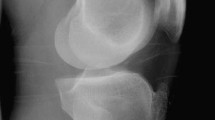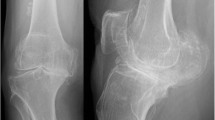Summary
The increase of knee lesions within the last years has provoked a generally more intensive discussion about the functional anatomy, the biomechanics and the pathophysiology of the capsule and ligaments of the knee joint. Several authors have stressed the importance of the active and passive factors, stabilizing the knee joint. The injury to a single element leads to different instabilities, as proven by meticulous clinical and radiological diagnostic procedures. The progress in the treatment of fresh and old injuries of knee ligaments is connected with the names of O'Domoghue, Slocum, Larson, Hughston, Nicholas and Trillat. For a fresh completely ruptured ligament surgery is recommended. Torn menisci are reattached whenever possible. An initial graft can be necessary for ruptures of the anterior cruciate ligament. Complex injuries, which are found most frequently, have to be dealt with completely. Old injuries of capsule and ligaments may require a plastic reconstruction. For the reconstruction of the anterior cruciate ligament it has been proven useful to take distally attached tendons of the pes anserinus group as well as the free graft from the central 1/3 of the patellar ligament. Rotational instabilities have to be dealt with according to the type of instability. The techniques of Slocum and Larson and the “five in one” reconstruction by Nicholas have to be emphasized as treatment of the anteromedial rotational instabilities. McIntosh has shown a procedure which seems to be successful for anterolateral rotational instabilities. Several techniques have been compared with our own experiences and late results studied. The point is stressed that further progress has to be made for the treatment of injuries to ligaments of the knee.
Zusammenfassung
Die Zunahme von Kniebinnenschäden hat in den letzten Jahren dazu geführt, daß allgemein eine intensivere Auseinandersetzung mit den Fragen der funktionellen Anatomie, der Biomechanik und Pathophysiologie des Kapselbandapparates erfolgte. Auf die Bedeutung der das Kniegelenk stabilisierenden aktiven und passiven Elemente wurde von verschiedenen Autoren hingewiesen. Die Verletzung einzelner Elemente führt zu unterschiedlichen Instabilitäten, die durch eine differenzierte, klinisch und röntgeneologische Diagnostik nachweisbar sind. Die in den letzten Jahren erzielten Fortschritte in der Therapie frischer und veralteter Kniebandverletzungen sind mit den Namen O'Donoghue, Slocum und Larson, Hughston, Nicholas und Trillat verbunden. So wird heute für die komplette frische Bandruptur die operative Therapie empfohlen. Wenn möglich, werden abgerissene Menisci erhalten. Eine primäre Bandplastik kann bei vorderen Kreuzbandrupturen notwendig werden. Komplexverletzungen, um die es sich in der Regel handelt, müssen vollständig versorgt werden.
Veraltete Kapselbandverletzungen können eine plastische Rekonstruktion erfordern. Hier hat sich für das vordere Kreuzband die Verwendung distal gestielter Sehnen aus der Pes anserinus-Gruppe sowie das freie Ligamentum patellae-Transplantat aus dem zentralen Drittel bewährt. Rotationsinstabilitäten sind nach der Instabilitätsform durch spezifische Operationsverfahren zu beseitigen. Besonders hervorzuheben sind für die antero-mediale Rotationsinstabilität die Operationstechniken nach Slocum und Larson sowie die “five-one”-Rekonstruktion nach Nicholas. Für die antero-laterale Rotationsinstabilität hat MacIntosh ein erfolgversprechendes Verfahren angegeben.
Die Beurteilung der verschiedenen Techniken wurde durch klinikeigene Erfahrungen und Nachuntersuchungen belegt. Dabei wird klar herausgestellt, daß weitere Fortschritte in der Behandlung der Kniebandverletzungen angestrebt werden müssen.
Similar content being viewed by others
Literatur
Burri, C., Hutzenschenreuter, P., Pässler, H. H., Radde, J.: Functional postoperative care after reconstruction of knee ligaments. An experimental study. In: The Knee joint. Amsterdam: Excerpta Medica 1974
DiStefano, V., O'Neil, R., Nixon, J. E., Davis, O.: Pes anserinus transfer: An in vivo biochemical analysis. J. Bone Jt. Surg. 58-A, 285 (1976)
Hertel, P., Schweiberer, L.: Biomechanik und Pathophysiologie des Kniebandapparates. Hefte Unfallheilk. 125, 1 (1975)
Hughston, J. C., Andrews, J. R., Cross, M. J., Moschi, A.: Classification of Knee Ligament instabilities. Part. I + II. J. Bone Jt. Surg. 58-A, 159 (1976)
Kennedy, J. C., Fowler, P. J.: Medial and anterior instability of the Knee. J. Bone Jt. Surg. 53-A, 1257 (1971)
MacIntosh, D. L., Darby, T. A.: Lateral substitution reconstruction. J. Bone Jt. Surg. 58-B, 142 (1976)
Marty, A.: Evaluation of fresh Ligamentous injuries of the Knee. 7th International Syposium on topical Problems in Orthopaedic Surgery Lucern 1976
Menschik, A.: Mechanik des Kniegelenkes, 1. Teil. Z. Orthop. 112, 481 (1974)
Müller, W.: Die Rotationsstabilität am Kniegelenk. Hefte Unfallheilk. 125, 51 (1975)
Nicholas, J. A.: The five-one reconstruction for antero-medial instability of the Knee. J. Bone Jt. Surg. 55-A, 899 (1973)
Noyes, F. R., Sonstegard, D. A.: Biomechanical function of the pes anserinus at the Knee and the effect of its transplantation. J. Bone Jt. Surg. 55-A, 1225 (1973)
O'Donoghue, D. H.: Surgical treatment of fresh injuries to the major ligaments of the Knee. J. Bone Jt. Surg. 32-A, 721 (1950)
O'Donoghue, D. H.: Reconstruction for medial instability of the Knee. J. Bone Jt. Surg. 55-A, 941 (1973)
Refior, H. J.: Kombination der Pes anserinus-Plastik mit verschiedenen bandplastischen Maßnahmen — Indikation, Technik, Ergebnisse. Vortrag 40. Jahrestagung der „Deutschen Gesellschaft für Unfallheilkunde e. V.“. Berlin, 18.–20. 11. 1976
Refior, H. J., Wirth, C. J.: Der plastische Ersatz veralteter Kreuzbandrupturen. I. Material, Methoden und Indikationen. Z. Orthop. 114, 913 (1976)
Slocum, D. B., Larson, R. L.: Pes anserinus transplantation. J. Bone Jt. Surg. 50-A, 226 (1968)
Slocum, D. B., Larson, R. L.: Rotatory instability of the Knee. J. Bone Jt. Surg. 50-A2, 211 (1968)
Steinbrück, K. H.: Wintersportverletzungen an Sprunggelenk und Unterschenkel. Dtsch. Ärzteblatt 53, 3399 (1976)
Trillat, A.: Chirurgie du genon. Paris: Masson 1973
Wirth, C. J., Jäger, M.: Die veraltete anteromediale Kniegelenksinstabilität — Frühergebnisse der Operation nach Nicholas. Orthop. Praxis (im Druck)
Wirth, C. J., Refior, H. J.: Der plastische Ersatz veralteter Kreuzbandrupturen. II. Spätergebnisse. Z. Orthop. 114, 922 (1976)
Author information
Authors and Affiliations
Rights and permissions
About this article
Cite this article
Witt, A.N., Jäger, M., Refior, H.J. et al. Das instabile Kniegelenk — aktuelle Gesichtspunkte in Grundlagenforschung, Diagnostik und Therapie. Arch orthop Unfall-Chir 88, 49–63 (1977). https://doi.org/10.1007/BF00415058
Received:
Published:
Issue Date:
DOI: https://doi.org/10.1007/BF00415058




